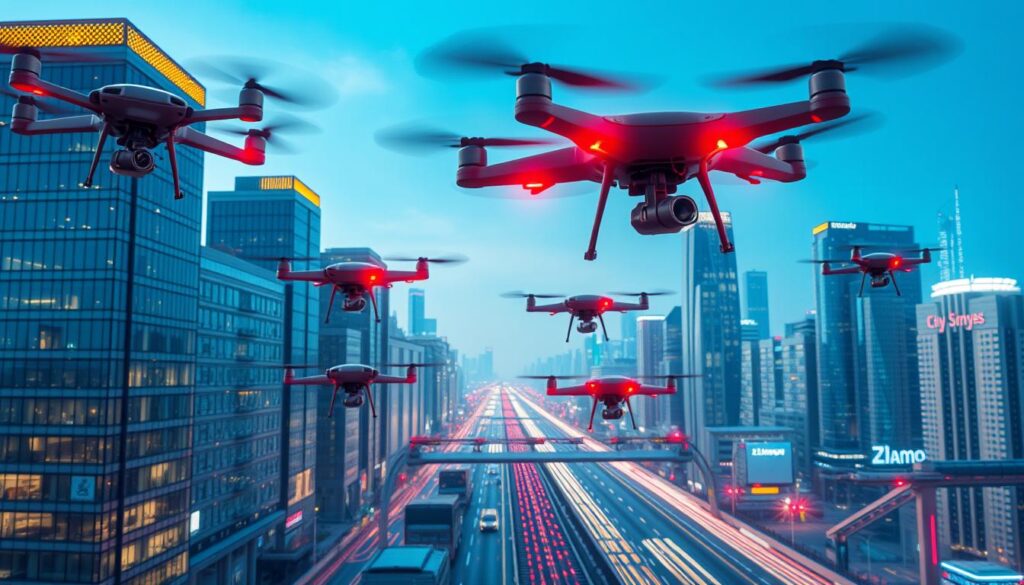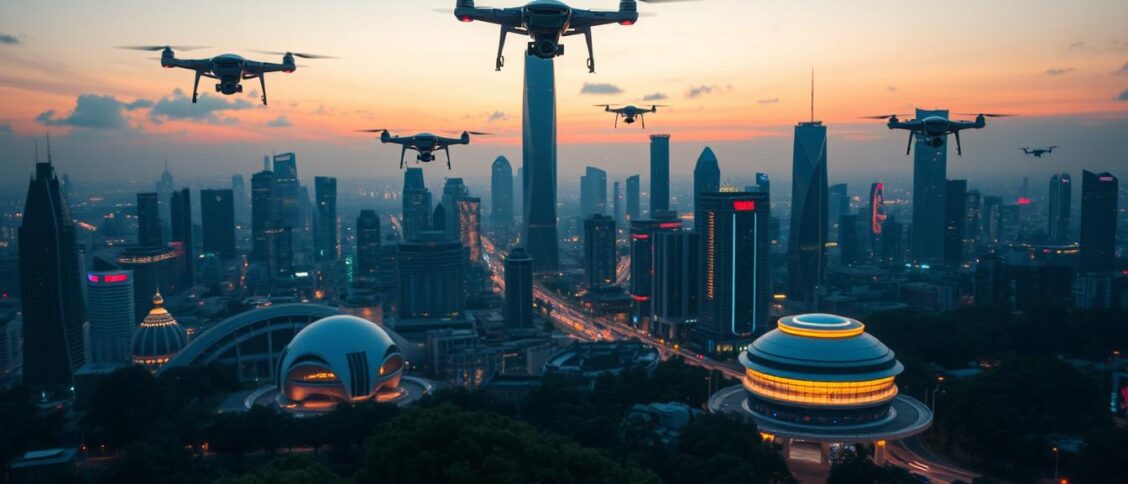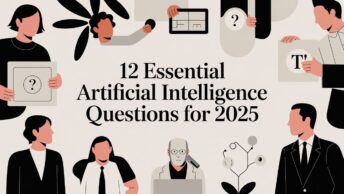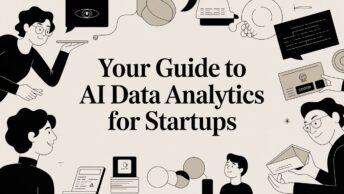Are we entering an era where drones fly themselves, changing industries and the sky above? Autonomous drones, once just for watching from afar, are now key in technology’s growth. In the United Kingdom, drones show an amazing mix of self-control and AI. This mix aims to change fields like logistics and farming with high precision and efficiency. AI’s role in drones is not just a big leap; it’s a huge step into a future. Here, drone tech goes beyond what we can imagine, affecting our daily lives with its many uses.
The University of Missouri is leading in this tech by working on visual navigation for drones. This lets drones move through tough spots. With predictions of the drone market hitting $53.4 billion by 2030, innovation is key. Companies like Aero360 are creating solutions for big challenges.
Drones are set to change how goods are delivered and improve farming by watching crops closely. But, their rise faces challenges like public trust and safety rules.
Drone autonomy relies on complex tech like computer vision and machine learning. There is a careful plan for drones to safely share the sky, ensuring they fly without trouble and stick to ethical rules.
Engineers are building in extra safety measures to make sure AI can handle tough weather and different places. Keeping people safe is a top goal.
AI drones have a big role in industries, improving how we monitor our world and plan cities. With new sensor tech and machine learning, drones have a lot of promise for the future.
Unmanned Aerial Vehicle Evolution and AI Integration
Drones, or unmanned aerial vehicles (UAVs), have changed a lot because of tech advances. They started in the military but now are everywhere in business. AI has made drones much smarter. It lets them do things without a person guiding every move. This is thanks to AI algorithms and better ways to find their way around.
The Historical Perspective of Drone Development
The story of drones started in the 18th century, aimed at military use. Through years, notably in World War II and the Vietnam War, tech upgrades boosted drones’ roles in spying and tactics. By the 2000s, people saw their value beyond war, bringing a big shift towards commercial use.
Breakthroughs in AI that Revolutionise Drone Capabilities
AI has brought big changes to drones, especially in making them smarter and more efficient. Thanks to computer vision and machine learning, drones can plan routes better and avoid obstacles smoothly. The drone market is expected to grow, reaching USD 38.3 billion by 2027 with a 7.9% growth rate each year.
AI is key for safer and more efficient flights. It helps drones handle wind, landscape changes, and blockages well. The use of small drones in the military is also increasing. It’s expected to push market growth during the next years.
In places like farming and traffic control, drones are becoming important tools. AI helps them work better, which is good for the planet too. It makes flight paths better and cuts down on fuel use.
The future of AI drones is bright, with big changes expected in delivery services and more. The drone delivery market could hit $5.5 billion by 2030. This shows we’re moving towards smarter, more self-sufficient drone operations, all thanks to AI.
Principles of AI in Autonomous Drones
AI and machine learning have greatly improved drones, especially for avoiding obstacles and navigating. High-quality cameras and LiDAR sensors let these drones gather and analyze live visual data. They use AI to identify images and pinpoint objects. This progress is key as worries grow over drones possibly invading privacy by secretly filming from almost anywhere.
Machine learning is essential because it trains drones with large datasets. This training lets drones adjust to new situations and constantly improve how they fly. Thanks to deep learning, drones can learn from huge data amounts without humans. This gives them the power for dynamic route planning, allowing them to navigate complex paths on their own.
The use of AI in drones for military and watching operations raises ethical questions. Drones are now common in warfare, highlighting concerns about moral issues of using lethal autonomous weapons with limited human control. The lack of human supervision brings up big ethical and legal problems. This has led the United Nations to suggest rules requiring meaningful human control over lethal autonomous weapon systems.
The call for AI regulation is getting louder worldwide, shown by talks at the United Nations. Key players have called for strict agreements on using autonomous systems without human help. They underline the need for ethical standards and responsibility in AI use. Military approaches are also evolving, with progress in AI integration showing moves towards using autonomous features wisely and with care.
Revolutionising Navigation Systems Through AI
Artificial Intelligence (AI) has taken drone use to new heights, well beyond just fun. It plays a big part in many fields today. This leap is mostly thanks to better computer vision and smarter navigation.
The Role of Computer Vision in Flight
Drones use computer vision to see and understand their surroundings. This lets them do difficult jobs on their own, whether in busy cities or remote areas. For example, companies like Amazon Prime Air and Wing are changing how we get packages in cities. They use drones that can smartly find their way around, all thanks to AI.
Advanced Path Planning and Dynamic Obstacle Avoidance
For drones to be safe, knowing how to dodge things in their path is key. They use AI and tools like lidar to change their route on the fly. This is super helpful in emergencies like natural disasters, where drones can get to places in need fast.
The agriculture world also benefits big time. AI drones help watch over crops, find pests, and figure out the best watering plans, boosting farm results. And in keeping things like bridges and power lines in check, drones ensure things stay safe and work well.
As AI keeps getting better, the future of smart drones looks bright. They promise to bring even more advancements across different areas, making them a valuable tool for many.
Surveillance to Service: Diverse Drone Applications
Artificial Intelligence (AI) and drones are changing the game in many areas. They make a big difference in how we watch over things and serve others. Now, we can do more than just keep an eye on places. We are improving search and rescue, farming, and deliveries.
Transforming Search and Rescue Missions
Drones are now key to search and rescue jobs. They make finding people faster and safer, even in tough places. Their high-tech cameras and thermal imaging spot survivors from the sky. This way, help arrives quickly and covers more ground, making rescue missions more successful.
Autonomous Drones in Agriculture: Precision Monitoring and Crop Management
In farming, drones are a game-changer. They have sensors and GPS to check crops like never before. This helps farmers know exactly what their crops need. So, they can grow more food using less resources.
Facilitating Swift and Sustainable Delivery Mechanisms
Drones are also reshaping deliveries, especially in busy cities. They find the best paths to deliver things fast and without harm. This is not just handy but good for the planet too. It cuts down pollution from usual delivery trucks.
Drones are doing much more than flying around taking pictures. They’re a big part of work in many fields now. Their mix of watching from above, smart farming, and new delivery ways is not just changing how we do things but also preparing for the future.
AI Piloting: Advantages in Safety and Efficiency
The world of drones has changed a lot with AI. This change makes drones work better and safer in many areas.
Thanks to AI, drones can now fly on their own and spot objects while moving. This helps a lot in tasks like watching over areas and saving people by spotting risks quickly. AI also helps drones plan the best way to fly. This keeps them safe and efficient, following rules perfectly.
Enhancing Operations with Real-Time Decision-Making
AI helps drones make quick decisions during important tasks. This is great for farming drones that need to change how they water crops based on the weather. In building sites, drones can check everything fast and make sure plans are right.
Reducing Human Error through Autonomous Flight Systems
Drones flying on their own mean fewer mistakes caused by people. They work on their own for jobs like mapping, needing less help from us. These smart systems can also find problems before they get worse, making drones last longer and work safer. In unsafe places, like after a natural disaster, drones can collect important information safely.
By adding AI to drones, companies get better and safer work. This is changing how work is done worldwide.
Regulation and Airspace Management: Adapting to Technological Advancement
Drones are flying higher in our lives, especially in business and fun activities. This boom demands new rules and better airspace systems. With AI-powered drones joining the sky, old air traffic systems struggle to keep up, risking safety and smooth operations.
The move to smart skies is not just happening, it’s needed. AI-guided Unmanned Traffic Management (UTM) systems will help handle the sky’s future complexities. The European Aviation Safety Agency has a plan that shows AI’s role in safe drone use in busy places and tight skies.

Keeping up with drone tech means clear rules that evolve with new inventions. The World Economic Forum highlights this need for guidelines. This ensures safety, builds public trust, and protects privacy in a world where drones are everywhere.
Worldwide, we must work together to make tech that fits into current flying rules. Advancements in AI have turned drones from simple flyers to smart systems that navigate on their own, analyse data quickly, and watch over the environment.
In China, they’re creating self-managing air traffic systems, a giant leap for drone interactions. These innovations, like the EH216 autonomous air vehicle, show the bright future of flying and why countries must work together on rules.
As drones get smarter, the way we manage the sky and follow rules must also get smarter. AI drones with the power to fix themselves and adapt need clever airspace control and legal guidelines.
Learning from AI’s role in different areas shows the need for airspace strategies that are ready for today and tomorrow’s drone tech.
Addressing the Challenges of AI-Powered Flight
The world of AI-powered drones is growing fast, bringing exciting changes to many fields. But, it’s facing big challenges that we need to sort out for it to reach its full potential. Top issues include making rules that work globally and improving drone technology for longer flights.
Global Standards for Regulatory Challenges
AI drones are popping up in areas like farming, watching over places, and delivering goods. It’s really important to have strong worldwide rules for these drones. This is not only for keeping us safe and protecting privacy, but it also helps new ideas grow within the law. The drone tech market is expected to hit $84 billion by 2030, growing fast. This shows how much we need laws that can keep up with new tech and more drones flying around. Nations are racing to make detailed rules that cover flying space, drone checks, and keeping data private.
Battery Life and Energy Considerations in Extended Missions
Battery life is a big problem stopping more use of AI drones. For long tasks like helping in disasters or checking on nature, drones need to fly longer. We need new tech to make batteries last longer for these important jobs. This challenge is making experts look for better ways to save energy and try new power sources while drones do their work.
Current Landscape and Research in AI-Enhanced Drones
Adding AI to drones is a game-changing move. It turns them into key tools for many sectors. Research in AI is always finding new limits for these smart machines. They are getting better at working together and using 5G, making them more efficient and effective.
Swarm Intelligence: The Next Frontier of Collective Unmanned Operations
Swarm intelligence brings a big change to how drones work together. With this tech, drones can sync up and learn from each other without humans. AI makes this even better, letting drones do things like search and rescue or monitor the environment more efficiently.
These drones can quickly gather and analyze data. This is key for making fast and well-informed decisions when they are flying on their own.
5G Connectivity: Ushering in High-Performance Autonomous Operations
5G is changing the game for drones that operate on their own. It brings faster data speeds and very low delay. This boosts how drones talk and process data. With 5G, AI drones can do more complex tasks with better precision and faster, like in the military or for smart cities.
Also, 5G helps drones become even smarter. This opens up new possibilities for how they can be used. Examples include checking crops in farming or watching areas for the military.
With new findings in research and better AI and 5G tech, drones are set to grow like never before. They will be more independent and connect better, revolutionizing how they fly.
The Role of Generative AI in Future Drone Technologies
Generative AI (GenAI) is changing the game for drone tech. It’s making drones smarter in navigation, checking places from afar, and surveillance. Thanks to GenAI, drones are now more able to make decisions and work better.
How GenAI is Shaping Smart Navigation and Surveillance
GenAI gives drones the power to think better. This means they can navigate with great accuracy and handle information fast. This is crucial for surveillance. With this tech, drones are 25% better at moving on their own through tricky places. For watching and following objects, GenAI has boosted accuracy by 40%.
Improving Remote Inspection and Maintenance with GenAI Drones
In fields like building and farming, GenAI-powered drones are making things easier and cheaper. They cut inspection costs by 20% and get more done, 15% faster. In farming, these high-tech drones have upped efficiency by 35%. They better monitor crops and manage water.
By using GenAI, drones are not just tech marvels. They are bringing real benefits to many areas. These benefits include better safety, more efficiency, and dependable performance.
Software Innovations Shaping Next-Gen AI Drones
The AI drone sector is changing fast, thanks to big leaps in software. These changes help drones do more and work better. Now, drones are not just flying on their own. They also have smart features that make them more useful and powerful.
These features are creating a future where drones can do a lot more. They’re becoming key players in different fields, changing how we do things.
Real-Time Mapping and the Importance of Machine Learning
Real-time mapping is key for AI drones. It lets them move smoothly and adjust to new things around them. With machine learning, drones can quickly use the data they gather while flying. This means they can make quick decisions.
Machine learning gets better with time. It learns from past flights to improve. Drones can now map out areas and spot problems with crops. This leads to better farming practices.
Collaborative Swarming for Enhanced Productivity and Accuracy
Collaborative swarming is another big step. It’s about many drones working together, guided by smart algorithms. This way, they can do tasks better than one drone alone. It’s used in things like keeping an eye on places, watching the environment, and farming.
By working together, drones can cover big areas quickly. They keep data quality high and stay safe. This technique makes tasks more accurate.
These tech advances are changing many industries, like farming and emergency response. Faster, more precise drone work can really make a difference. By adding machine learning and swarming, we see how AI can improve drones. It shows how important real-time mapping and smart planning are today.
Real-World Impact of AI-Driven Drones on Key Industries
AI-driven drones are changing sectors by making operations more efficient. These drones combine smart navigation with instant data processing. They’re perfect for tough places in logistics, ecosystem checking, and city planning.
Boosting Efficiency in Logistics and Delivery Services
In logistics, AI drones are a big deal now, not just a dream. They speed up deliveries, especially to hard-to-reach spots. Companies like Amazon and Zipline use these drones to cut delivery times and costs. This improves both efficiency and customer happiness. Experts think the AI drone market could hit $84 billion by 2030, showing huge growth potential.
Ecosystem Monitoring and Contributions to Environmental Conservation
AI drones are a key step forward in saving our environment. They track biodiversity changes and watch over natural homes without harm. Drones gather data efficiently over big, tough spots, like rainforests or oceans. So, they’re vital in caring for and guarding our natural resources.
Urban Planning and Development with Intelligent Aerial Insights
Urban planning is getting a boost from AI drone insights. These drones help with mapping, traffic, checking infrastructures, and planning cities better. Their advanced detection and quick response change cityscapes, fitting them to people’s changing needs.
AI drones are truly changing various fields, showing they’re great for doing tasks better and bringing benefits for everyone.
Conclusion
The growth of autonomous drone operations is closely linked to the progress in AI technology. This marks a critical stage in the formation of future drone uses. The rise of AI in this area is not just about new tech. It’s also about its power to change various industries. These range from urgent emergency services to eco-friendly farming methods. Thanks to AI and drone data, farmers can now pick the best times to harvest. This increases profits and reduces waste. Also, AI makes drone flying safer and tasks more efficiently done. All these factors are pushing the drone market’s value up. It may reach $54.6 billion in the next ten years.
However, this incredible growth comes with its set of challenges. One major issue is creating rules that keep up with UAV tech’s quick progress. The FAA and other bodies are working on guidelines for safe and complex drone flights. This is part of a global move to set legal boundaries for drones in the sky. Yet, the current rules struggle to keep pace with ongoing technological leaps. These cover various legal levels worldwide. The job and economic benefits are huge. For example, the drone sector in Europe might create 100,000 jobs. It could also make more than €10 billion a year within two decades. This shows the major influence of this sector.
Drones powered by AI predict a future where they can make decisions alone and adjust to different situations. However, the link between human control and automated accuracy is still key. AI is boosting drones’ ability to recognise patterns and make quick decisions. Still, this underlines the ongoing need for human skill in flying drones. This partnership forms the foundation of the drone industry’s future growth. Looking at the future of drones, AI, and their applications, we see a complex path. It is full of regulations, but it leads to a new and changing world.
FAQ
What are the key breakthroughs in AI that have revolutionised drone capabilities?
Key AI breakthroughs transforming drones include computer vision and machine learning. Also, path planning and avoiding obstacles dynamically have been important. These advancements help drones make smarter decisions and work more efficiently, by letting them see and respond to their surroundings.
How is AI piloting improving the safety and efficiency of autonomous drone operations?
AI piloting boosts drone safety through quick decision-making and dodging obstacles, cutting down human mistakes. It makes flights smoother and cuts the need for people to step in. This lets drones work well even in tough places.
In what ways are autonomous drones being used beyond military applications?
Apart from military uses, drones work in search and rescue, farming, checking infrastructure, watching over the environment, and delivering packages. They show how drones change the game in many fields.
What is the significance of airspace management and regulatory challenges in the development of AI-powered drones?
Managing airspace and rules are key to mix drones safely with other aircraft and keep everyone’s trust. We need clear rules and systems that handle new tech to tackle the challenges of flying drones together with other planes.
How does swarm intelligence and 5G connectivity influence the current landscape of AI-enhanced drones?
Swarm smarts make drones work together better, boosting their performance in tasks like finding lost people or checking infrastructure. 5G will change drone operations with faster communication and data handling, making complex tasks easier.
What are the limitations of current AI-powered drones, and what is being done to address them?
Today’s drones face hurdles like unclear rules, short battery life, and safety worries. Work is being done on better batteries, explainable AI, and global standards to overcome these issues and get more people to use drones.
How does generative AI (GenAI) contribute to the capabilities of future drone technologies?
GenAI boosts drones’ abilities in finding their way, watching over things, and upkeep. It gives them skills like humans’ to recognise patterns and decide on actions. This lets drones inspect places remotely, more on their own, and do it well.
What software innovations are shaping the next generation of AI drones?
New software like instant mapping, adding machine learning, and drones working together are key to the future of AI drones. These developments improve how they work, keep them safe, and make them easier to use, showing why software matters a lot.
Can you explain the real-world impact of AI-driven drones on key industries?
AI drones speed up delivery, helping the environment, and keep an eye on nature to protect it. They also help plan cities and build things, making them vital for solving big problems today.
What future drone applications could be expected as AI technology progresses?
With AI getting better, drones will take on tougher tasks with less help from us. Expect them to do more complex search and rescue, manage crops and pests by themselves, handle busy skies, and respond to emergencies quickly.
Source Links
- Navigating the Skies: How Autonomous Drones and AI are Revolutionizing Logistics, Agriculture, and… – https://medium.com/kinomoto-mag/navigating-the-skies-how-autonomous-drones-and-ai-are-revolutionizing-logistics-agriculture-and-ed9c9edce2e2
- AI Takes Flight: Unveiling the Future of Autonomous Drones – https://aero360.co.in/ai-takes-flight-unveiling-the-future-of-autonomous-drones/
- PDF – https://arxiv.org/pdf/2310.16360
- Enhancing Drone Autonomy Using AI-Powered Algorithms – https://www.azorobotics.com/Article.aspx?ArticleID=689
- No title found – https://falconediting.com/en/blog/the-role-of-ethics-in-autonomous-drone-technology/
- AI and the Future of Drone Warfare: Risks and Recommendations – https://www.justsecurity.org/89033/ai-and-the-future-of-drone-warfare-risks-and-recommendations/
- AI in Autonomous Drones: Navigating Complex Environments – https://fpgainsights.com/artificial-intelligence/ai-in-autonomous-drones-navigating-complex-environments/
- Revolutionizing drone navigation: AI algorithms take flight – https://engineering.missouri.edu/2024/revolutionizing-drone-navigation-ai-algorithms-take-flight/
- AI and Autonomous Drones: Applications in Surveillance, Delivery, and Exploration – https://medium.com/@futureaiweb/ai-and-autonomous-drones-applications-in-surveillance-delivery-and-exploration-5d65388bc54b
- AI-Equipped Drones: 20 Revolutionary Use Cases for drone technology – https://djm-aerial.com/ai-equipped-drones-revolutionary-use-cases/
- AI & Drones: Boosting Efficiency, Safety & Innovation | Carrot – https://www.carrot.co.uk/hertfordshire-drone-articles/ai-machine-learning-transforming-drone-efficiency-safety.asp
- The Ultimate Guide to Autonomous Drones: Benefits, Applications, and Top Models – https://www.jouav.com/blog/autonomous-drones.html
- What the new EU Artificial Intelligence Act means for drones, UTM and eVTOLs – Unmanned airspace – https://www.unmannedairspace.info/uncategorized/what-the-new-european-union-artificial-intelligence-act-will-mean-for-drones-utm-and-evtol-operations/
- AI Revolution & Drones: The Future and Counter-Solutions – https://sentrycs.com/the-counter-drone-blog/the-evolution-of-ai-in-drones-implications-and-adaptations-for-counter-drone-technology/
- AI In Drone Technology: Explore How It Works In Detail – https://www.zealousys.com/blog/ai-in-drone-technology/
- AI and Drones 🤖 | OpenMind – https://www.bbvaopenmind.com/en/technology/artificial-intelligence/ai-and-drones/
- AI in Drones: Benefits, Use Cases and Challenges for Businesses – https://appinventiv.com/blog/ai-in-drones/
- AI and Drones: Advancements and Applications in Unmanned Aerial Vehicles — visionplatform – https://visionplatform.ai/artificial-intelligence-drones/
- The Future of Gen-AI powered Drone Advancements – MulticoreWare – https://multicorewareinc.com/the-future-of-gen-ai-powered-drone-advancements/
- Role of Artificial Intelligence in Shaping Drone Capabilities – mPower – https://mpowerlithium.com/blogs/blog/the-role-of-artificial-intelligence-in-shaping-drone-capabilities?srsltid=AfmBOorhFpdhrK6mUrPfx5BDw84zWGjdEY5tB8dEK7VVPlXzcI_Nmp5u
- AI in Autonomous Drones: Transforming Aerial Operations – https://redresscompliance.com/ai-in-autonomous-drones-transforming-aerial-operations/
- Drone and Counter-Drone Industries: The Revolutionary Impact of AI – https://www.smartdatacollective.com/drone-and-counter-drone-industries-revolutionary-impact-of-ai/
- SURVAIR – https://www.survair.com/survair-blog-posts/ai-and-drones
- Artificial Intelligence and Drones – https://www.linkedin.com/pulse/artificial-intelligence-drones-yash-thummar-sfywc
- Artificial Intelligence, Autonomous Drones and Legal Uncertainties | European Journal of Risk Regulation | Cambridge Core – https://www.cambridge.org/core/journals/european-journal-of-risk-regulation/article/artificial-intelligence-autonomous-drones-and-legal-uncertainties/BDB89BEC2266D1ABF17316A53AA93480
Discover more from Scott Dylan
Subscribe to get the latest posts sent to your email.






